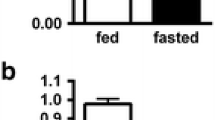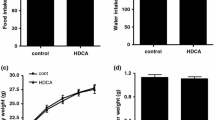Abstract
The hepatic metabolism of oleic acid and n−3 fatty acids (eicosapentaenoic acid, EPA and docosahexaenoic acid, DHA), and secretion of very low density lipoprotein (VLDL) were studied in isolated perfused rat livers from normal chow fed male rats. The basal perfusion medium contained 30% bovine erythrocytes, 6% bovine serum albumin (BSA), and 100 mg/dL glucose, in Krebs-Henseleit bicarbonate buffer (pH 7.4) which was recycled through the liver for 2 hr. Individual fatty acids (EPA, DHA or oleic acid), as complexes with 6% BSA, or albumin alone, were infused at a rate of 70 μmol/hr. When any of these fatty acids was infused at this rate, the ambient concentration in the medium was maintained at 0.3–0.4 μmol/mL, indicative of similar hepatic rates of uptake for each fatty acid (i.e., approximately 6 μmol/g liver/hr). When fatty acid was not infused, the ambient free fatty acid level was 0.16 μmol/mL. The concentrations of infused free fatty acids increased appropriately in the perfusion medium; however, with infusion of EPA, DHA, or oleate, the concentrations of perfusate palmitate and linoleate were the same as when fatty acid was not infused. Additionally, the perfusate concentration of oleate in the free fatty acid fraction was not affected by infusion of EPA and DHA. These data indicate a constant outflow of endogenous fatty acid unaffected by the presence of the exogenously supplied fatty acid.
The net secretion rate of VLDL lipids and protein was stimulated by infusion of oleate, whereas when EPA was infused, secretion rates were lower and similar [except for VLDL cholesterol (C), which was greater] to those occuring when fatty acid was not provided. DHA stimulated the secretion of VLDL triacylglycerol (TG), phospholipid (PL) and C to a similar rate, as did oleate, but secretion of VLDL cholesteryl ester (CE) and protein was lower and similar to that with EPA. VLDL and hepatic TG and CE were enriched with the infused fatty acids, compared to experiments without fatty acids, as determined by gas chromatography. Enrichment of PL, however, was significant only in liver upon infusion of EPA. The formation of14CO2 and perchloric acid soluble products from [1-14C]EPA, considered separately, did not differ statistically from that obtained with [1-14C]oleate, although the mean values were higher with [1-14C]EPA. However, the sum of oxidation products derived from EPA was significantly greater than that from oleate. Incorporation of [1-14C]EPA into TG and CE, but not into PL, was lower as compared to that from [1-14C]oleate. These lower rates of incorporation of [1-14C]EPA into VLDL lipids therefore paralleled the mass fatty acid enrichment-patterns. It may be concluded that EPA is used to a similar extent as oleate for synthesis of PL, but is a poorer substrate for synthesis of TG. The reduced output of newly synthesized (radioactive) PL reflected the lower hepatic output of VLDL. Since hepatic uptake of EPA, DHA or oleate was identical, utilization of EPA for TG synthesis was less than that of oleate or DHA. Further-more, utilization of endogenous fatty acids for TG synthesis and secretion of the VLDL was reduced in the presence of EPA. The decreased TG synthesis resulted in reduced formation of VLDL for transport of TG from the liver. These effects taken together with an apparently increased oxidation of EPA provide substantial evidence for a decrease in formation of VLDL and transport of TG, PL, C and CE into the circulation in response to EPA. DHA, however, appears to be an adequate substrate for TG synthesis and stimulates VLDL secretion. The reduced transport of CE may reflect lower selectivity of DHA by acyl-CoA; cholesterol acyltransferase for CE formation.
Similar content being viewed by others
Abbreviations
- ACAT:
-
acyl-CoA:cholesterol acyltransferase; apo, apolipoprotein
- BSA:
-
bovine serum albumin
- C:
-
cholesterol (unesterified)
- CE:
-
eholesteryl esters
- EPA:
-
eicosapentaenoic acid (20∶5)
- DHA:
-
docosahexaenoic acid (22∶6)
- FA:
-
fatty acid
- FFA:
-
free (unesterified) fatty acid
- GC:
-
gas chromatography
- PL:
-
phospholipid
- TG:
-
triacylglycerol
- VLDL:
-
very low density lipoprotein
References
Harris, W.S., Connor, W.E., and Murray, M.C. (1983)Metabolism 32, 179–184.
Phillipson, B.E., Rothrock, D.W., Connor, W.E., Harris, W.S., and Illingworth, D.R. (1985)N. Engl. J. Med. 312, 1210–1216.
Daggy, B., Arost, C., and Bensadoun, A. (1987)Biochim. Biophys. Acta 920, 293–300.
Choi, Y.-S., Goto, S., Ikeda, I., and Sugano, M. (1989)Lipids 24, 45–50.
Huff, M.W., and Telford, D.E. (1989)Arteriosclerosis 9, 58–66.
Nestel, P.J., Connor, W.E., Reardon, M.R., Connor, S., Wong, S., and Boston, R. (1984)J. Clin. Invest. 74, 82–89.
Wong, S., and Nestel, P.J. (1987)Atherosclerosis 64, 139–146.
Wong, S.H., and Marsh, J.B. (1988)Metabolism 37, 1177–1181.
Wong, S.H., Nestel, P.J., Trimble, R.P., Storer, G.D., Illman, R.J., and Topping, D.L. (1984)Biochim. Biophys. Acta 792, 103–109.
Nossen, J.O., Rustan, A.C., Gloppestad, S.H., Malbakken, S., and Drevon, C.A. (1986)Biochim. Biophys. Acta 879, 56–65.
Parks, J.S., Johnson, F.L., Wilson, M.D., and Rudel, L.L. (1990)J. Lipid Res. 31, 455–466.
Homan, R., Grossman, J.E., and Pownall, H.J. (1991)J. Lipid Res. 32, 231–241.
Wong, S.-H., Fisher, E.A., and Marsh, J.B. (1989)Arteriosclerosis 9, 836–841.
Lang, C.A., and Davis, R.A. (1990)J. Lipid Res. 31, 2079–2086.
Wilcox, H.G., Zhang, Z.J., and Heimberg, M. (1989)Fed. Proc. 3, A643.
Wilcox, H.G., Dunn, G.D., and Heimberg, M. (1975)Biochim. Biophys. Acta 290, 39–54.
Heimberg, M., Fizette, N.B., and Klausner, H.A. (1964)J. Am. Oil Chem. Soc. 41, 774–779.
Keyes, W.G., and Heimberg, M. (1979)J. Clin. Invest. 64, 182–190.
Wilcox, H.G., and Heimberg, M. (1987)J. Lipid Res. 28, 351–360.
Newman, H.A.I., Liu, C.T., and Zilversmit, D.B. (1961)J. Lipid Res. 2, 403–411.
Rieser, F., Siakotos, A.N., and Fleischer, S. (1966)Lipids 1, 85–86.
Rudel, L.L., and Morris, M.D. (1973)J. Lipid. Res. 14, 364–366.
Stajner, A., and Suva, J. (1977)J. Chem. Clin. Biochem. 15, 513–514.
Stakkestad, J.A., and Bremer, J. (1982)Biochim. Biophys. Acta 711, 90–100.
Keyes, W.G., Wilcox, H.G., and Heimberg, M. (1981)Metabolism 30, 1135–1146.
Morrison, W.R., and Smith, L.M. (1964)J. Lipid Res. 5, 600–608.
Lowry, O.H., Rosebrough, N.J., Farr, D.L., and Randall, R.J. (1951)J. Biol. Chem. 193, 265–275.
Markwell, M.A.L., Haas, S.M., Bieber, L.L., and Tolbert, N.E. (1978)Anal. Biochem. 87, 206–210.
Van Harken, D.R., Brown, T.O., and Heimberg, M. (1967)Lipids 2, 231–233.
Kohout, M., Kohoutova, B., and Heimberg, M. (1971)J. Biol. Chem. 246, 5067–5074.
Wilcox, H.G., Woodside, W.F., Breen, K.J., Knapp, Jr., H.R., and Heimberg, M. (1974)Biochem. Biophys. Res. Commun. 58, 919–926.
Heimberg, M., Wilcox, H.G., Dunn, G.D., Woodside, W.F., Breen, K.J., and Soler-Argilaga, C. (1974) inRegulation of Hepatic Metabolsim (Lundquist, F., and Tygstrup, N., eds.) pp. 119–141, Munksgaard, Copenhagen.
Khan, B., Wilcox, H.G., and Heimberg, M. (1989)Biochem. J. 259, 807–816.
Heimberg, M., Dunn, G.D., and Wilcox, H.G. (1974)J. Lab. Clin. Med. 83, 393–400.
Wong, S., Reardon, M.F., and Nestel, P.J. (1985)Metabolism 34, 900–905.
Rutsan, A.C., Nossen, J.O., Christansen, E.N., and Drevon, C.A. (1988)J. Lipid Res. 29, 1417–1426.
Cianflone, K.M., Yasruel, Z., Rodriguez, M.A., Vas, D., and Sniderman, A.D. (1990)J. Lipid Res. 31, 2045–2055.
Author information
Authors and Affiliations
About this article
Cite this article
Zhang, Z.J., Wilcox, H.G., Elam, M.B. et al. Metabolism of n−3 polyunsaturated fatty acids by the isolated perfused rat liver. Lipids 26, 504–511 (1991). https://doi.org/10.1007/BF02536594
Received:
Revised:
Accepted:
Issue Date:
DOI: https://doi.org/10.1007/BF02536594




